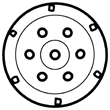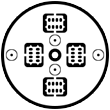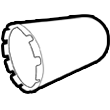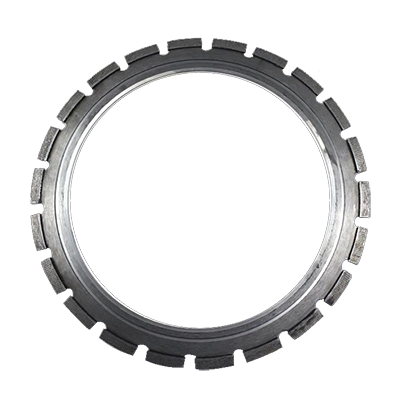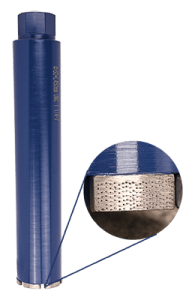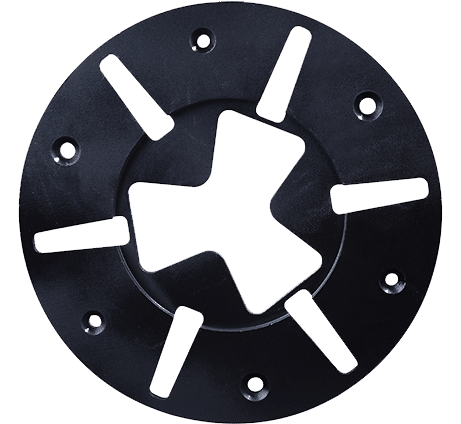
2 Diamond Tools Welding Methods: High-Frequency VS Laser
May 3, 2024“Diamond segments are the functional parts of a metal-bonded diamond tool.”
– from Wikipedia
As a functional component of diamond tools, the diamond segments are vitally important, whether for cutting, grinding, or drilling. But how to ensure the quality of diamond segments? We can find the answer in the diamond segment production flow, which consists mainly of 9 steps for making diamond segments.
Table of Contents
1. Diamond powder preparation
Diamond segments are formed by mixing diamond powders under high temperatures and pressure. So, in the first step, we should prepare the diamond powders according to specific diamond formulas. A professional diamond tools manufacturer should have developed various diamond formulas to cut/grind/drill different kinds of materials, including granite, marble, concrete, reinforced concrete, and more. These diamond formulas are intangible assets and trade secrets of the factory. So not all workers can be in this position to prepare the diamond powders. This person should be trusted by the company to ensure the diamond formulas won’t be leaked.
The worker knows the proportions of diamonds and each metal powder. Then he/she will weigh different metal powders according to the proportions of the segment formula. 2 things should be considered:
Weighing the metal powders and diamonds
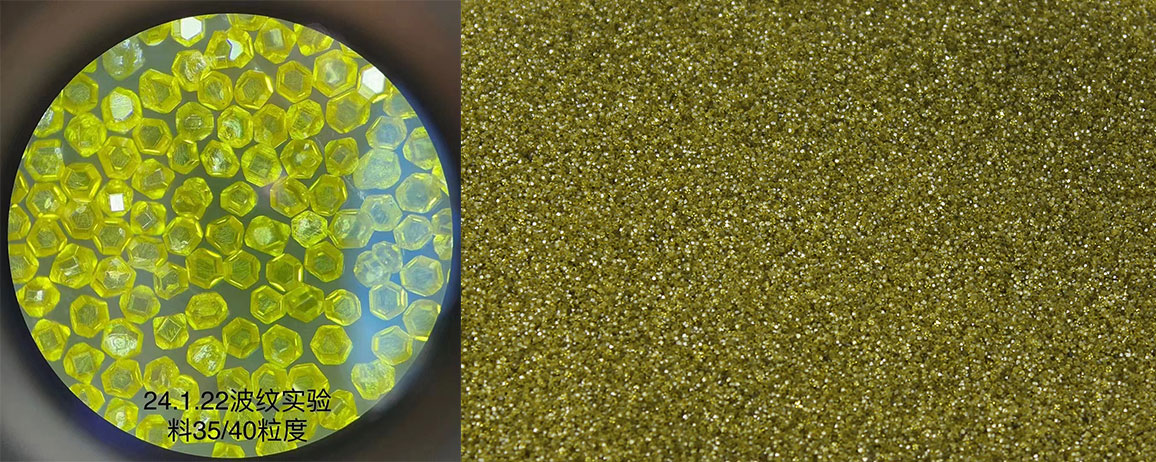
35/40 grits diamond particles
For diamond powder preparation, accurate weighing is very important. If there is a big error in weighing, the proportion of each element will be changed, so it will alter the diamond formula and render every subsequent step meaningless.
The quality of raw materials
Except for the weighing, the quality of raw materials is also essential. The diamonds and other metal powders should be pure and free of other impurities, or you will encounter some problems. For example, several years ago, we encountered a problem when manufacturing an order of concrete grinding segments. The 30/40 grit concrete grinding segments were mixed with 16/20 bigger diamond particles. We discovered this after sharpening the segments, as the larger diamond particles were visible on the surface, making it very obvious. This rendered all the segments useless.
Upon investigation, we found that the reason was that when weighing the diamonds, the worker accidentally mixed 16/20 grit diamonds into what should have been 30/40 grits. Later, we learned from this mistake and optimized our workflows, and this issue never recurred.
The problem is that the errors in the first step are very hidden and difficult to detect. When you find the errors, it’s too late and all the segments become useless.
After weighing, it goes to the next step – Diamond Powder Mixing.
2. Diamond powder mixing
Before cold pressing, the diamond powder should be mixed sufficiently with the help of mixers. Different mixing machines have different capacities and performances, so the mixing time will vary. But generally, the mixing should last at least 2 hours to ensure thorough mixing of the powders. The mixing process is automatic. Just set the duration, and it will run automatically, stopping at the time you set.
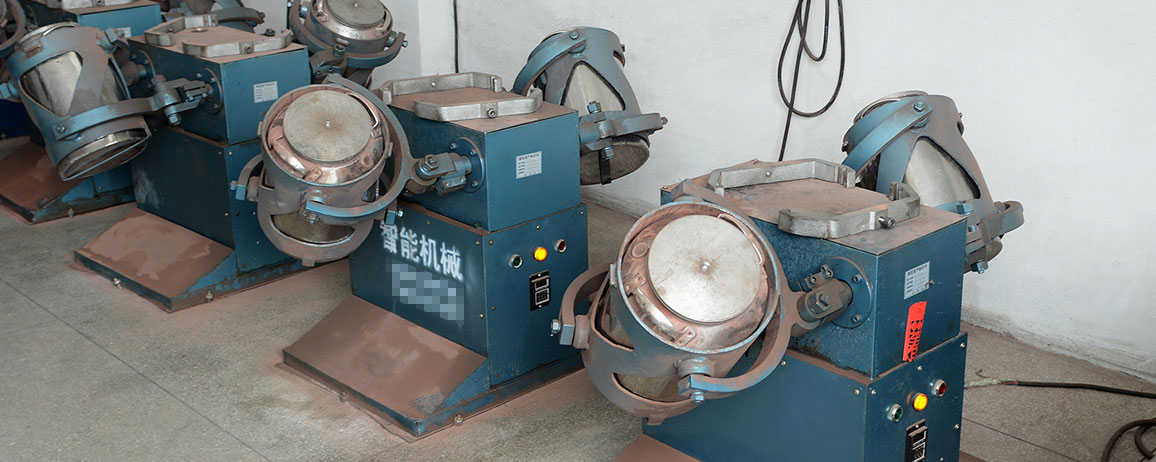
Mixing diamond powders with mixers
After being well mixed, the diamond powders can be sent to the cold pressing machine for cold pressing.
3. Cold pressing
First, to better understand the cold pressing process, we need to know the structure of the diamond segments. The diamond segments actually have different layers; some contain diamonds, and we call them working layers, while others do not contain diamonds, and we call them transition layers. For multi-layer diamond segments, it has both working layers and transition layers, and these two different layers are combined alternately. In sandwich segments, there are three layers. Both layers have diamonds, but the side layers have a higher diamond concentration.
Now that we have some knowledge of the structure of diamond segments, let’s return to the cold pressing process. Cold pressing involves pressing the diamond powders to form the single layers of the segment (which can be a transition layer or working layer) using molds and pressure.
The cold pressing process is automatic. The performance of the machine will affect the productivity and quality of the cold-pressed layers. A good cold-pressing machine will produce well-shaped segment layers with high efficiency.
After production, the workers will inspect the cold-pressed layers and pick out those that don’t qualify. Then, these layers are set aside for segment molding.
Cold pressing of Arix diamond segments
Arix diamond segments feature arrayed diamonds on the surface of each segment layer. They are sharper than normal segments and specialized for cutting or drilling hard materials like hard granite, concrete, and reinforced concrete, with high productivity and stable performance.
There are two methods for cold pressing Arix segments: ‘Fully automatic using an Arix segment cold pressing machine’ OR ‘With the assistance of both machinery and labor’.
If cold-pressing the Arix segments fully automatically, we require a specialized cold pressing machine designed for Arix segments. While this machine comes with a significant cost, it offers high productivity and consistent quality.
The second type uses the normal cold pressing machine, and labor is involved in the process. Normal cold pressing machines create cold-pressed segment layers (without diamonds), and then workers use a mold to arrange the diamonds on each segment layer. With this type, you don’t need to invest in an exclusive machine and can save costs, but you may need to sacrifice productivity and quality.
The fully automatic cold-pressing of Arix segments is typically sold separately because it offers a large production scale, more stable quality, and can recoup the investment cost of the machine. Conversely, Arix segments made by the second method are usually not sold separately, for its small quantity. The factories use them on the diamond blades they are selling.
INFO: Except for arix concrete cutting blades and arix concrete core drill bits, Diamond Tools for Concrete also offers corresponding premium Arix diamond segments for retipping. They are extremely sharp for cutting or drilling high-rebar-contented reinforced concrete (increase 30%-50% cutting speed) and can be used for dry applications.
4. Diamond segments molding
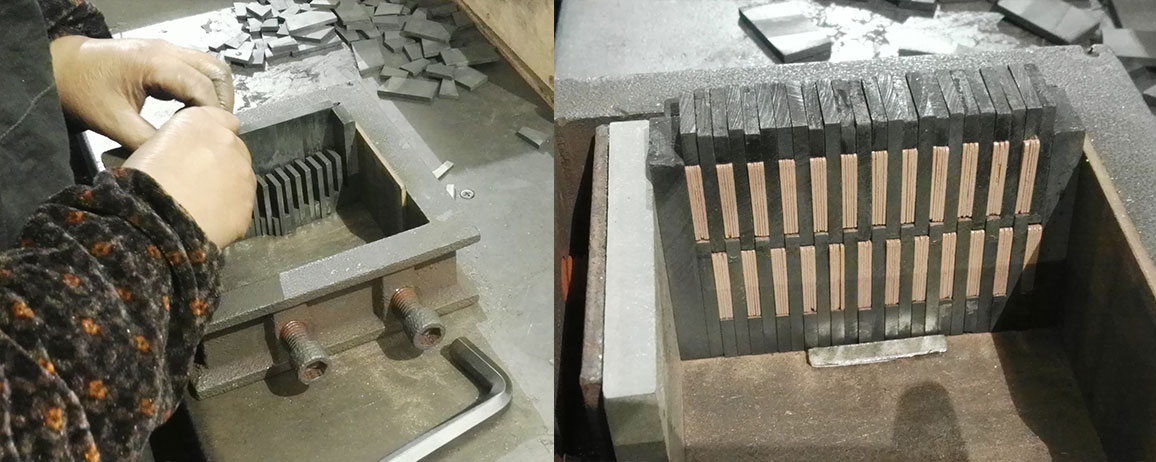
Multi-layers diamond segments molding
Segment molding is the process of arranging the different segment layers into the mold, in preparation for hot pressing. This step is done manually. Similar to the structure we learned from cold pressing, workers need to arrange different layers alternately—one working layer with one transition layer—into several graphite molds. These molds are then fixed into a steel frame using bolts. The proficiency of workers and the type of segments will affect the efficiency of molding. The finished steel frames will be placed on an iron shelf with rollers, awaiting hot pressing.
5. Hot pressing
Cold pressing forms the segment layers physically, while hot pressing forms the whole segment chemically. Under high temperature and pressure, chemical reactions occur between diamond powders, ultimately forming a diamond segment.
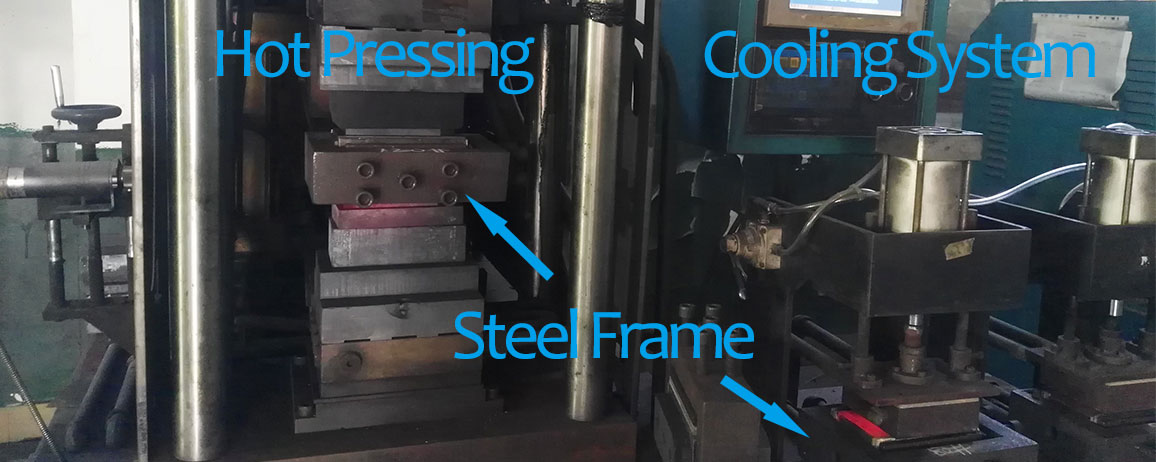
Hot-pressing diamond segments
The workers place the segment molds into the hot pressing machine and then set the parameters such as temperature, pressure, and time. The hot pressing machine operates automatically. After completing the hot pressing, the frame will be cooled by a water circulation system.
6. Diamond segments demolding
When the temperature of the segment molds cools down, it’s time to remove the segments from the molds. The workers need to unlock the frame and remove all the segments and graphite molds, separating them into different areas. They will conduct a preliminary visual inspection, removing any unqualified segments.

Demolding button shape concrete grinding segments
Now, we have the initial diamond segments, but most of them have rough edges or burrs. We need to remove the burrs and make the segments have smooth edges, a process called sandblasting.
7. Sandblasting
Sandblasting is a very common process in the industry. It is a surface treatment technique commonly used to clean and remove surface dirt, oxide, rust, coatings, or other unwanted materials. When used for diamond segments, it is employed to remove the burrs on the surface.
With this step, the production of diamond segments is completed, and they need to be inspected.
8. Diamond Segment inspection
Segment inspection is necessary to ensure the quality of diamond segments. It helps us identify defective products and remove them, ensuring our segments have stable quality. There are several main aspects to inspect: appearance, dimensions, weight, and strength.
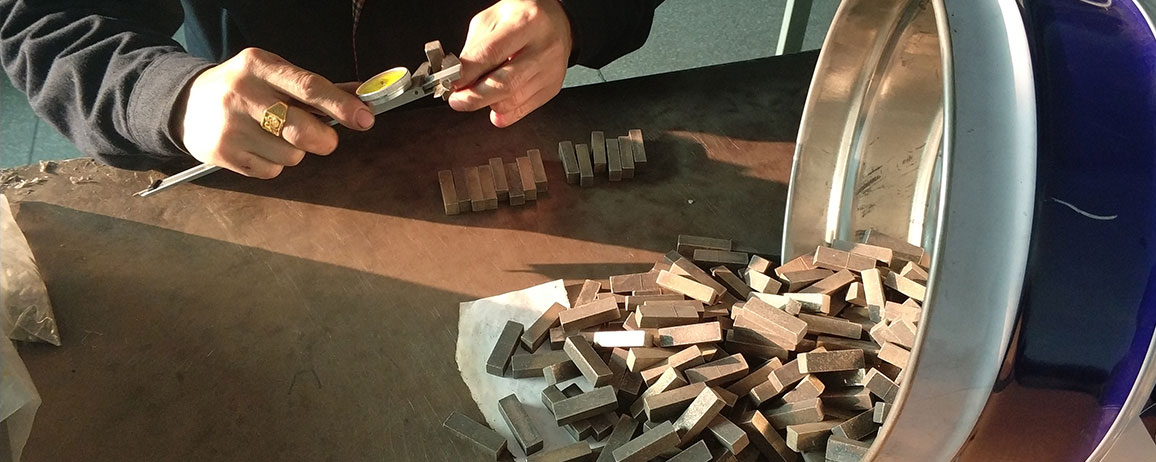
Inspection diamond segments
For the same batch of diamond segments, random strength testing is required. Meanwhile, the other three inspections need to be applied to each segment to ensure segment quality.
After inspection, the segments can be packed and delivered to customers.
9. Diamond Segment packaging
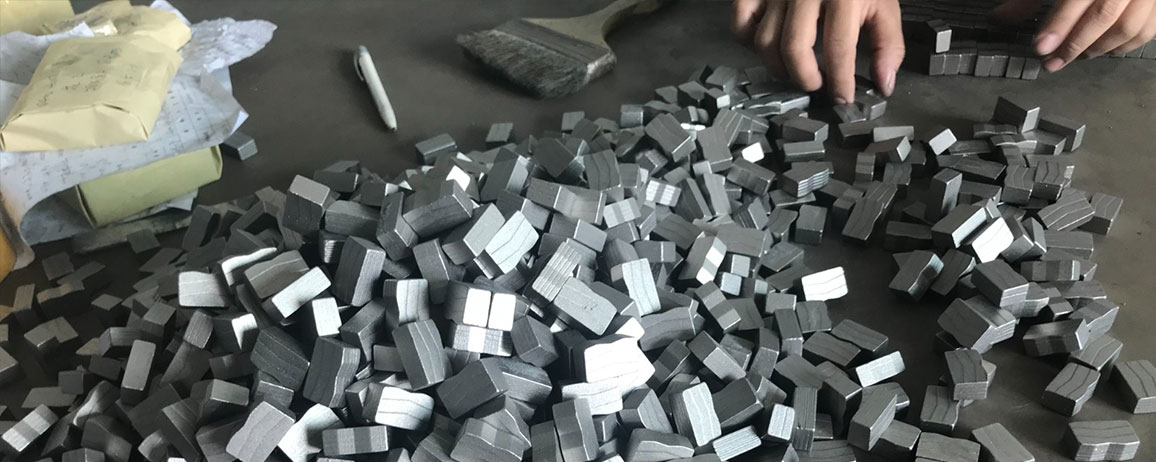
Packing diamond segments
Segment packing is the last step of making diamond segments, making them ready for delivery and ensuring their protection during shipping. The worker neatly piles the diamond segments on the table and then packages them in certain quantities using yellow wrapping paper. A product label is placed on the outside to indicate the segment size and the materials they can cut. Finally, the packed segments are placed into hard boxes in preparation for delivery.
Conclusion
The above 9 steps encompass all the procedures involved in manufacturing diamond segments. In conclusion, diamond segment production is a complex process. Whether the order quantity of segments is large or small, a certain amount of time is required because each step needs to be completed in sequence.
All the steps are accompanied by a production sheet containing necessary information such as the segment size, application, and machine parameters (such as the temperature and pressure of the hot pressing machine) to ensure the segments can be produced according to the production plan.
Xpert Diamond Tools produces excellent diamond segments and uses them in our diamond tools, resulting in outstanding performance in cutting/grinding/drilling various materials including granite, marble, asphalt, concrete, reinforced concrete, and other construction materials.



